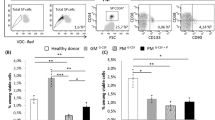Abstract
Mobilized peripheral blood progenitor cells (PBPC) are increasingly used as an alternative to bone marrow for autografting procedures. Currently, cyclophosphamide (CY) followed by granulocyte colony-stimulating factor (G-CSF) or G-CSF alone are the most commonly used PBPC mobilization schedules. In an attempt to investigate whether the use of these two mobilization regimens could result in the collection of functionally different CD34+ cells, we analyzed nucleated cells (NC), CD34+ cells, committed progenitor cells and long-term culture initiating-cells (LTC-IC) in 52 leukaphereses from 26 patients with lymphoid malignancies, mobilized either by CY+G-CSF (n = 16) or G-CSF alone (n = 10). Thirty-four aphereses from the CY+G-CSF group and 18 aphereses from the G-CSF group were investigated. According to the study design, leukaphereses were carried out until an average number of 7 × 106 CD34+ cells/kg body weight were collected. The mean (± s.e.m.) numbers of CD34+ cells mobilized per apheresis by CY+G-CSF and G-CSF were not significantly different (2.76 ± 0.6 × 108 vs 2.53 ± 0.4 × 108, P ⩽ 0.7). This resulted from a mean number of NC that was significantly lower in the CY+G-CSF products than in the G-CSF products (12.4 ± 1.7 × 109 vs 32 ± 5.4 × 109, P ⩽ 0.0001) and a mean incidence of CD34+ cells that was significantly higher in the CY+G-CSF products than in the G-CSF products (2.9 ± 0.6% vs 0.9 ± 0.2%, P ⩽ 0.0018). The mean (± s.e.m.) number of CFU-GM collected per apheresis was significantly higher in the CY+G-CSF group than in the G-CSF group (37 ± 7 × 106 vs 14 ± 2 × 106, P ⩽ 0.03). Interestingly, CY+G-CSF-mobilized CD34+ cells had a significantly higher plating efficiency than G-CSF-mobilized CD34+ cells (25.5 ± 2.9% vs 10.8 ± 1.9%, P ⩽ 0.0006). In addition, the mean number of LTC-IC was significantly higher in the CY+G-CSF products than in the G-CSF products (6.3 ± 1 × 106 vs 3.3 ± 0.3 × 106, P ⩽ 0.05). In conclusion, our data provide evidence that CY+G-CSF and G-CSF induce the mobilization of CD34+ cells with different clonogenic potential. As mobilized PBPC containing large numbers of progenitors lead to safer transplantation, this issue may have implications for planning mobilization strategies.
This is a preview of subscription content, access via your institution
Access options
Subscribe to this journal
Receive 12 print issues and online access
$259.00 per year
only $21.58 per issue
Buy this article
- Purchase on Springer Link
- Instant access to full article PDF
Prices may be subject to local taxes which are calculated during checkout
Similar content being viewed by others
Author information
Authors and Affiliations
Rights and permissions
About this article
Cite this article
Cesana, C., Carlo-Stella, C., Regazzi, E. et al. CD34+ cells mobilized by cyclophosphamide and granulocyte colony-stimulating factor (G-CSF) are functionally different from CD34+ cells mobilized by G-CSF. Bone Marrow Transplant 21, 561–568 (1998). https://doi.org/10.1038/sj.bmt.1701133
Received:
Accepted:
Published:
Issue Date:
DOI: https://doi.org/10.1038/sj.bmt.1701133
Keywords
This article is cited by
-
Importance of blood graft characteristics in auto-SCT: implications for optimizing mobilization regimens
Bone Marrow Transplantation (2011)
-
A randomised study comparing peripheral blood progenitor mobilisation using intermediate-dose cyclophosphamide plus lenograstim with lenograstim alone
Bone Marrow Transplantation (2004)
-
G-CSF Alone vs cyclophosphamide plus G-CSF in PBPC mobilization of patients with lymphoma: results depend on degree of previous pretreatment
Bone Marrow Transplantation (2003)
-
Mobilizing potential of ifosfamide/vinorelbine-based chemotherapy in pretreated malignant lymphoma
Bone Marrow Transplantation (2001)



